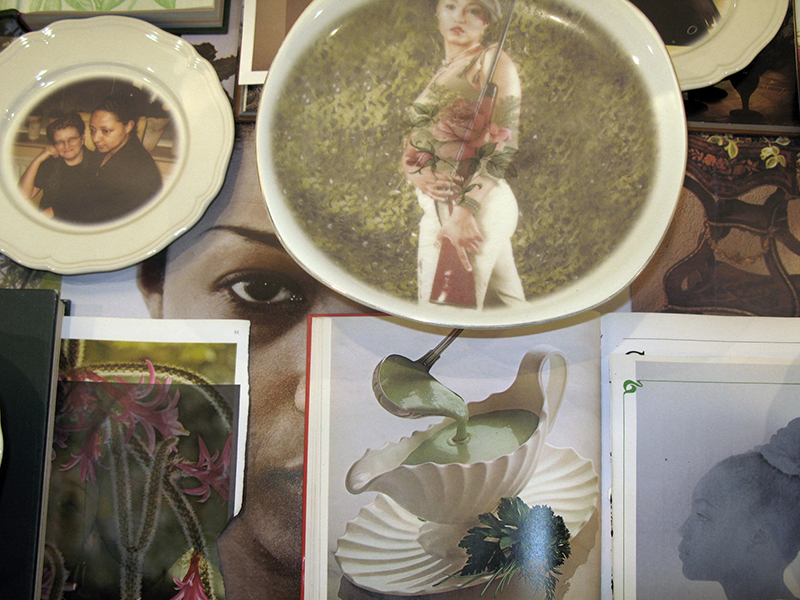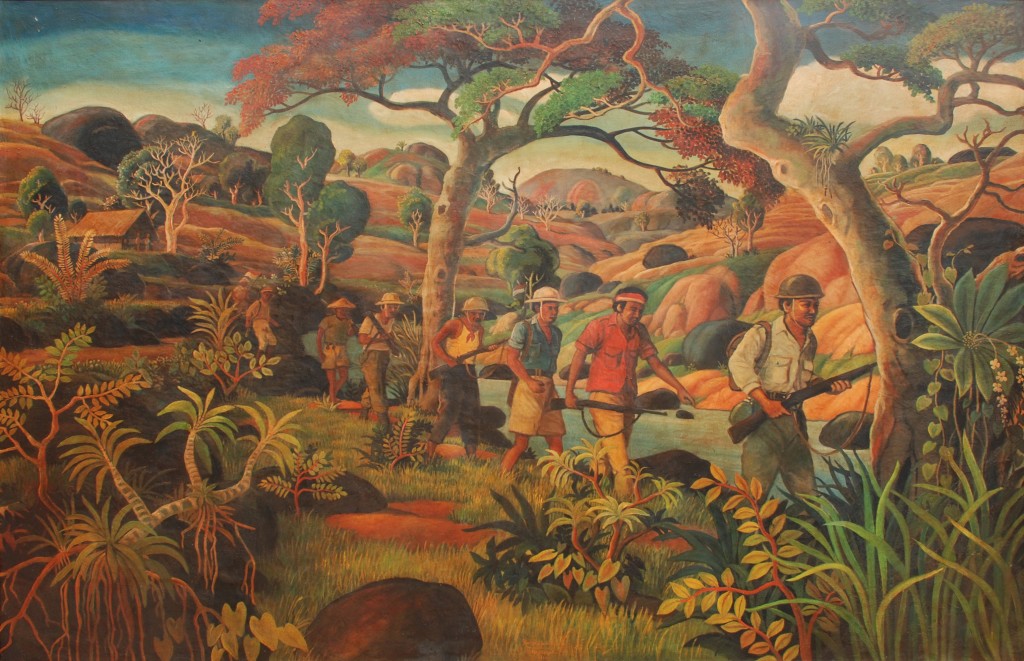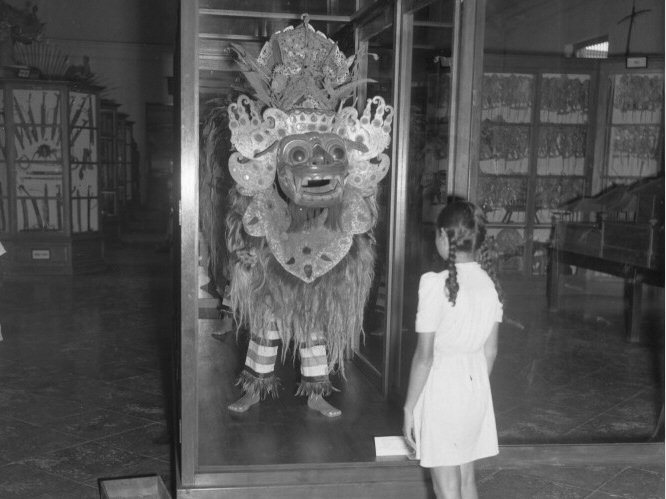 Rose Mary Allen, lecture at Framer Framed (2017)
Rose Mary Allen, lecture at Framer Framed (2017) Report: Exploring oral history as autobiography in the Curaçaoan context
On the 5th of April 2017, Dr. Rose Mary Allen gave an open lecture at Framer Framed titled Oral History as (auto)biography: Exploring Curaçaoan-Cuban intra-Caribbean migration narratives; as part of the open lecture series on the influence of colonialism on the artistic expressions in former Dutch colonies. These lectures are organized throughout April and May 2017 together with the chair of Dutch-Caribbean Literature of the University of Amsterdam (currently held by Prof. Dr. Michiel van Kempen).
As with the rest of the open lectures, Michiel van Kempen introduced the event. In doing so he highlighted the importance of reconstructing history; particularly the history of cultures and populations that have been silenced. In many of these cultures, oral narratives are some of the strongest chronicled accounts that remain; and they are necessary to not only reconstruct a common memory, but also to counter and complete the authoritative and hegemonic historical narrative that has often erased many of its people. However, as Michiel stressed throughout his brief introduction, how does one build historical records from oral accounts and their intrinsic complexities?
Rose Mary Allen began her lecture by defining what oral history means: (I quote) “testimonies, personal recollection of people who have experienced certain events first hand, or who are sufficiently close to the event” to remember it. As she explained throughout the first part of her talk, her research centres on the recollection of orality in the Curaçaoan context. This translates in collecting data from people in an objective manner; focusing on a culture that is already familiar with the concept of orality (since oral history has been used for decades as a way of passing on stories and traditions in Curaçaoan society, from one generation to another). Additionally, oral narratives – here understood as not only speech, but also gestures, facial expressions, silence, singing, etc. – are not only limited to popular culture; as they are becoming established and acknowledged ways of (academic and non-academic) research. This is perhaps due to their “capacity to democratize history” (quoting the speaker); as oral history can link and re-write authoritative historical accounts with personal and local experiences.
In relation to this, during her introduction the speaker briefly associated aspects of oral history to the concept of (auto)biography, present in her lecture title; mentioning how, as an investigative practice, oral history can also be known as “biographical research” – because of its focus on personal memories and individual recollections (as well as facts). It is precisely the “intellectual refocusing of oral history as an (auto)biographical text” (in her own words) that informs Rose Mary Allen’s groundwork research practice: her studies of the migration of Curaçaoan workers to Cuba during the first years of the 20th century. Both her method and the historical framework of her work will be explained in detail throughout this report.
The speaker delved into the first part of her presentation by exploring the history of orality in Curaçaoan culture. As mentioned previously, the circulation of oral narratives is central to Afro-Curaçaoan society; as it was a way of not only passing on traditions but also resisting cultural erasure. Although these traditions – and the social events or gatherings they supported – were heavily persecuted, the use of orality persisted throughout the centuries (becoming, for instance, a crucial element for the survival of the history of enslavement).
The first in collecting the oral narratives (stories, songs, and myths) of Curaçao were Elis Juliana and Father Paul Brenneker, in the 1950s. These recordings – known as the Zikinzá collection – have become a relevant part of the history of the country. Additionally, if it wasn’t for them many of the stories and songs would have disappeared (the timeframe here is important, as the oldest person they interviewed was born ten years before the abolition of slavery in 1863). As the speaker explained, these records can be compared to the work of the Federal Writers’ Project of the Works Progress Administration (WPA) (who, quoting Rose Mary Allen, compiled “life histories of formerly enslaved people in the United States” during the 1930s and 1940s), in that they both move away from framing the participants as victims, and “recognize the active agency of enslaved persons within a system of bondage” (in her own words).
As for Rose Mary Allen, she started researching the topic of orality in the 1980s, whilst she was working in the Institute of Archaeology and Anthropology of the Netherlands Antilles (AAINA) in Curaçao. At that point, she began conducting interviews with Afro-Curaçaoan people of over 60 years of age (born between 1883 and 1926, coming from all parts of the island), gathering as much information as possible about the culture and society of Curaçao in the 19th and 20th centuries. These interviews covered a broad range of topics, including the social and spiritual life of the island, family narratives, and work customs of the era, as well as any recollections or transmitted information of the times of slavery. Like in the collected oralities of Brenneker and Juliana, the material Rose Mary Allen gathered aimed to enable, in her own words, a “re-interpretation of history”; as existing archives usually presented dominant (colonial) perspectives – and other narratives that did not come from this position were not included.
Throughout the interviews she conducted, a topic that would often re-appear would be the migration of people from Curaçao to other parts of the Caribbean. As the speaker explained, in the conversations held there was a recurrent emphasis on leaving the country to seek for a better life elsewhere, particularly for the working classes (notably corresponding with the Papiamentu saying “si bo no kana, bo atras no ta tembla”, which roughly translates as “if you don’t walk, your buttocks will not shake”[1] – highlighting the futility of standing still when wanting to earn a living). Not much was written in the historical records about the migration of Afro-Curaçaoan people throughout the second half of the 19th and the beginning of the 20th century; other than the fact that before the abolition of slavery the black working class were heavily stricken by poverty (and were therefore the most prone to migrate). This tendency continued after the abolition of slavery too (as did the poverty); as intra-Caribbean migration was often the chosen option for Afro-Curaçaoan workers. A noticeable event was the migration to Cuba at the beginning of the 20th century; of which very little was written in historical documents – despite it was the largest migration of Curaçaoan working class men up to that point.
Curaçao was an economically impoverished country at the time; which meant that, according to the speaker, probably around 50% of Curaçaoan men in their prime work age migrated. Women took part in this migration too (Rose Mary Allen particularly stressed this), but they were (unsurprisingly) not present in the official statistics of the time. The lecturer wondered, at this point of her research; what had this specific emigration to Cuba meant for both men and women – and what historical narratives and biographical approaches were missing from the authoritative records? With this question in mind, she narrowed her focus and searched for Curaçaoans who had experienced the Cuban migration, with the aim of interviewing them.
The search was difficult (as not many of these people were alive), but she eventually found both men and women interviewees who had gone to Cuba to work around 1917, and who had then returned to their country. Whilst away, men were mostly recruited as sugar cane workers[2]; while some women had gone to Cuba to work as nannies or cooks for Jewish Curaçaoan families – “either alone or with their partners or spouses”[3]. Rose Mary Allen also interviewed men who eventually settled in Cuba and did not return to their country, either because they had started a family – or because they had not made enough money (due to the sugar crisis that hit Cuba in 1921).
All in all, the lecturer collected a thorough amount of data. Throughout these interviews, the interviewees were given “free time to shape their own narratives” (quoting the speaker); and she focused not only on their story, but also on the facial and bodily expressions – thus having a complete picture of how these people recalled their memories.
Whilst reflecting on how these interviews mirror the practice of oral history, Rose Mary Allen pointed out that, as historical material, the collected data unearthed perspectives that would otherwise be missing from the dominant historical narratives. As the speaker said, this corresponded with the aim of oral history research; in that her project uncovered experiences that were not part of the established records. Additionally, in discussing the accuracy and certainty of the oral histories she gathered, Rose Mary Allen knowledgeably explained that (quoting her) “memory is not so much about the accuracy of an individual report, but about how and why people remember” certain things. In relation to this, it is perhaps more productive to focus on the following question than on the accurate or inaccurate aspects of an oral narrative: how does remembering a situation or event interact with the experience of being a gendered and racialized body?
The ambiguous and subjective nature of oral history pairs orality (and the research it involves) with the genre of autobiography; in that they are both concerned with individual people’s narratives. Interestingly, autobiographical texts have been widely used as a way of “redefining” (to use the lecturer’s term) one’s own life, as was the case with Frederick Douglass’ well-known autobiography Narrative of the Life of Frederick Douglass, an American Slave (famously published in 1845). To highlight the connection between oral history and the genre of autobiography, Rose Mary Allen analysed how the former can be interpreted as “identity narratives”; in that they investigate how interviewees frame their memories and become aware of their lives. In this way, then, both oral history and autobiographical narratives empower the speaker; creating a space for their voice to be recognised and heard, and for their history to be acknowledged (both on an individual and an institutional level).
The speaker stressed how the interviewees’ reflections and realizations shaped their own narrative of the Curaçaoan-Cuban migration (for instance, many of the people interviewed were deceived with the outcome of their immigration), often using figurative speech. As Rose Mary Allen explained towards the end of her lecture, the interviews she conducted illustrate the complex ways in which people build their own narratives; particularly stressing how the Curaçaoan-Cuban migration impacted these people’s lives and identities. In this sense, then (and quoting the lecturer), “oral history [can be interpreted as an] autobiographical practice [that] challenges the past”; in that it requires the interviewee to re-visit and narrate their lived experience. Additionally, the interviewee’s entire body is employed in the narration (not only the voice); meaning that (quoting the speaker once more) “oral history becomes autobiography through embodied performance”.
To close her lecture, Rose Mary Allen questioned if the interviews she conducted can be interpreted as autobiographies at all; since one could also argue that the role the interviewer takes decreases the narrative freedom of the interviewee. However, as it was made clear throughout the presentation, it is not about choosing one genre or narrative style over the other but understanding how they intersect; creating an (interdisciplinary) practice that allows for these experiences to be brought to light. In the lecturer’s words, the role the interviewer must take throughout this practice is that of understanding the strategy at play – ultimately unearthing the subjectivity of the narrative.
Once Rose Mary Allen ended her lecture, a lengthy Q&A session followed. The speaker answered questions related to several topics; including the intra-Caribbean migrations, the use of language in the interviews (language being a tricky instrument that can either bring you too close or set you too far apart from the interviewee), and the goals of her research. Upon discussing this last topic, Rose Mary Allen explained how she has tried to transmit the knowledge she gathered in an effective but careful way (as she feels responsible for the information she collected in her interviews). In relation to this, she has written a book in Papiamentu (Ta Cuba mi ke bai), as well as some articles in English and Spanish. After deliberating on other subjects – such as the danger of “contamination of data” when interviewing people on the topic of slavery, the role women who worked as nannies or cooks for Curaçoan Jewish families had, and the need for archives to adopt new models of accessibility –, we reached the end of the event. The evening ended as it had started, with Michiel van Kempen taking the floor to close the Q&A and announce the lectures to come; but with a head full of new knowledge on the need of exploring and re-framing history – and the encouraging tools to do so.
[1] “We are of the same blood”: The Curaçaoan-Cuban Intra-Caribbean migration in the conceptualization of identity and the politics of belonging; by Rose Mary Allen.
[2] Ibid.
[3] Ibid.
Report written by Iona Sharp Casas
Oral History / Caribbean / The living archive / Migration /
Agenda
Lecture: Rose Mary Allen - Oral history as autobiography
Lecture by Dr. Rose Mary Allen, on oral history in the context of Curacao.
Magazine


Report: Modern Indonesian painters in revolution and nation building

Report: Lecture by Gábor Pusztai on the work of László Székely

Report: What is modern Indonesian art?
